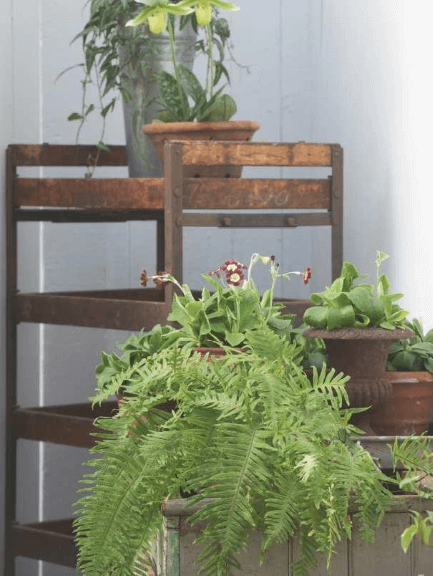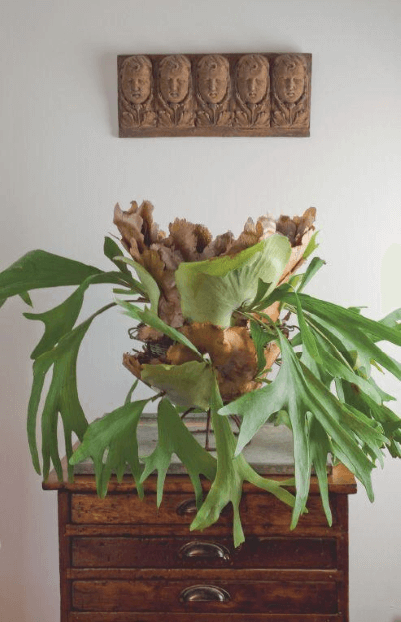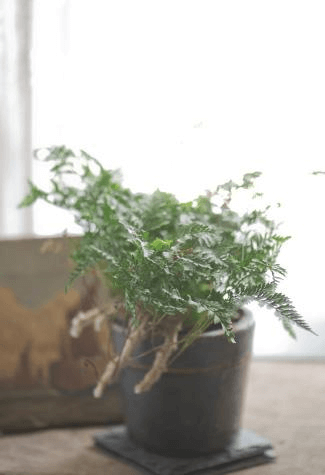[Ebook Việt hóa] The Unexpected Houseplant: 220 Extraordinary Choices for Every Spot in Your Home, Lớp Dương Xỉ - Polypodiopsida (Pteridophyta)
[Ebook Việt Hoá] The Unexpected Houseplant: Ferns (Pteridophyta, ngành Dương Xỉ)
- Nguồn: [Ebook] The Unexpected Houseplant: 220 Extraordinary Choices for Every Spot in Your Home –
- Biên tập: Dũng Cá Xinh (Tháng 02/2022)
- Dịch: Vui Nguyễn
English
FERNS
I NEED FLOWERS in winter. When it comes to rewards, I’m right alongside everyone who craves flowers when the garden refuses to comply. But I also need a respite; preferably a green oasis. And that’s where ferns come in.

Ferns are soothing. They have a certain inherent sophistication. Within your indoor garden, ferns are crowd control. Too many flowers jammed together, and the place begins to bear a disquieting resemblance to a bordello. You laugh, but you don’t want your home to look like a carnival scene. I prefer something quieter, so I balance out the bloomers with ferns.
Ferns have a hushed sort of splendor. They possess staying power. Their silhouette is architectural and sculptured; their fronds and fiddleheads display subtle innuendos of green, gray, smoky blue, chartreuse, and other variations in hue. Want a place where your eyes can fall and rest? Hire a fern.
Plus, ferns can fill a niche that might otherwise remain bereft of nature. Here’s a plant that will suffer your north-facing exposure and live to tell the tale. Sure, some ferns are a bear. Interestingly, I find that although Boston or sword ferns (nephrolepis) are omnipresent in nurseries, they are among the trickiest to grow in the average home. Without high humidity, they brown. Forget to water them once or twice, they get browner. Neglect them over a protracted period of time, and they go permanently into the wild brown yonder. It’s amazing that such a finicky fern has attained superstardom. An exception in the group is Nephrolepis cordifolia ‘Duffii’, a downsized version with tiny round pinnae (a fern’s substitute for leaves) lining the rachis (a fern frond’s midrib). Not only does it survive for me, but it tolerates occasional dryness and other abuse. Give the larger Nephrolepis cultivars plenty of root room. Keeping any fern from becoming root bound is a step in the right direction. Also on the “trouble” list in an indoor setting are all maidenhair ferns (adiantums), Hemionitis arifolia, and doodias, which I’ve tried and failed with innumerable times.
But the horticultural world is full of ferns that work brilliantly in a home. A personal favorite is the caterpillar fern, Polypodium formosanum. With sci-fi monster–green, caterpillar-size rhizomes that crawl over the top of the soil and chartreuse segmented fronds that shoot up, it gives some gardeners the creeps. But if you can’t handle nature’s sense of humor, you’re not going to find my home particularly amusing. Plus, Polypodium formosanum is forgiving, which is an important requisite in a houseplant. Repeated water neglect will cause the fronds to brown and the rhizomes to shrivel, but the rhizomes recover admirably and send up new fiddleheads when the breach is rectified. The caterpillar fern is just one possibility in this clan; other polypodiums are equally accommodating if you give them ample root-roaming room.
Along the same tangent but adding fur to the rhizomes, Humata tyermannii is another home workhorse. Some people make the association with tarantula legs when they encounter humata’s furry feet, but I prefer to think of squirrel paws. Impeccably tidy, low-growing, dark green fronds jut above the network of gray furred, creeping rhizomes. It’s a rapid grower and readily available.
Several aspleniums work for me. The bird’s nest fern, Asplenium nidus, with its flattened, ribbon-like fronds, verges on indomitable. A close second in the ironclad division is the bird’s nest’s cousin, Asplenium bulbiferum, which holds its family of piggyback plantlets on lacy fronds. Not only does Asplenium bulbiferum make multiple divisions, but you can just pull off the plantlets and tuck them into loose, humusy soil, and they will send out roots. It’s great for sharing with children.


All these ferns are well and good. But my pride and joy is a staghorn fern. Allow me to boast. It’s been a member of the family for so many years that I’ve lost count. Originally, I planted it in a wicker basket with a little built-in wire pedestal. Since then, my platycerium (I admit that I do not know the platycerium’s pedigree and it appears to be a bit of a mutt) has proceeded to send out flat plates around the outside of its basket as well as fertile staghorns jutting out in all directions. It has completely engulfed its container beyond recognition. Believe it or not, I drag it outside whenever the weather goes above freezing in winter and pour water through what remains of its container. During most winters (remember, I’m in New England), I can find an hour or so that is above freezing to run it outside once a week. If this sort of Olympic feat has you nervous, go the bathtub route and shower it down.
In the fear that someday my old staghorn buddy might bite the dust, I have a younger version in training. It is displayed with the more typical treatment of lashing the plant with fishing line to some sphagnum moss against a slab of wood. In summer, I hang it on my front door where normal people have their knockers. It never fails to impress first-time visitors and (hopefully) dissuade solicitors.
Pteridophyta
| FLOWERS | Not a factor |
| FOLIAGE | Various intriguing combinations of subtle shades of green |
| OTHER ATTRIBUTES |
Rather than the perk of flowers, ferns always look great |
| SIZE | Usually from 6 to 24 inches (15–61cm) in height |
| EXPOSURE | East or west preferable if pulled away from direct sunbeams; north also works |
| WATER REQUIREMENTS |
Ferns don’t like to dry out |
| OPTIMUM NIGHTTIME TEMPERATURE |
55–65°F (12–18°C) |
| RATE OF GROWTH | Slow |
| SOIL TYPE | Light, fluffy, humusy soil mix with a lot of organic matter |
| FERTILIZING | Early spring to late autumn |
| PROBLEMS | Prone to scale; tend to be sensitive to oil-based sprays |
Tiếng Việt
DƯƠNG XỈ (FERN)
TÔI CẦN HOA vào mùa đông. Khi nói đến phần thưởng, tôi cũng giống như những người khác, ao ước được sở hữu những bông hoa trong khu vườn. Nhưng tôi cũng cần thời gian nghỉ ngơi; tốt nhất là một ốc đảo xanh. Và đó là nơi dương xỉ xuất hiện.

Dương xỉ rất nhẹ nhàng. Chúng vốn có chút gì đó tinh tế nhất định. Trong khu vườn trong nhà, dương xỉ là loài kiểm soát đám đông. Nếu trong nhà có quá nhiều hoa chen chúc nhau, thì dương xỉ sẽ biến nơi này thành một nơi đáng kinh ngạc. Bạn cười sao, nhưng chẳng lẽ bạn không muốn biến ngôi nhà của mình thành một khung cảnh lễ hội. Tôi thích thứ gì đó yên tĩnh hơn, vì vậy tôi sẽ cân bằng các loại hoa với dương xỉ.
Dương xỉ mang đến cảm giác lộng lẫy một cách kín đáo. Chúng sở hữu sức mạnh lâu dài. Những cá bóng của chúng là một tác phẩm kiến trúc và điêu khắc; những chiếc lá lược và ngọn non của dương xỉ cho thấy màu xanh lá cây, màu xám, màu xanh lam khói, màu xanh lục nhạt, và các biến thể khác về màu sắc đầy tinh tế. Bạn muốn có một thứ để thư giãn và ngắm nhìn? Hãy thuê một cây dương xỉ.
Thêm vào đó, dương xỉ có thể lấp đầy mỗi một ngóc ngách. Đây là loại cây có thể chịu được ánh sáng hướng Bắc và có thể phát triển tiếp trước những khó khăn. Thật thú vị, tôi thấy rằng mặc dù dương xỉ Boston hay dương xỉ kiếm (nephrolepis) có mặt ở khắp nơi trong các vườn ươm, nhưng chúng lại là một trong những loài cây trong nhà khó trồng nhất. Nếu không có độ ẩm cao, chúng sẽ chuyển sang màu nâu. Quên tưới nước một hai lần, chúng sẽ sẽ chuyển sang màu nâu đậm. Bỏ mặc chúng trong một khoảng thời gian dài, chúng sẽ chết. Thật đáng kinh ngạc khi một cây dương xỉ kỳ lạ như vậy lại trở thành siêu sao. Có một ngoại lệ trong nhóm đó là Nephrolepis cordifolia ‘Duffii’, một phiên bản thu nhỏ với những lá chét tròn nhỏ (một loại lá thay thế cho lá của cây dương xỉ) lót bên trong cuống (gân nằm giữa lá lược của dương xỉ). Nó không chỉ sống tốt mà còn chịu đựng được tình trạng khô hạn thường xuyên và các tình trạng khác. Cung cấp nhiều không gian cho rễ của các giống cây Nephrolepis lớn phát triển. Giữ cho rễ cây không bị ràng buộc là một bước đi đúng đắn. Ngoài ra, trong danh sách những cây dương xỉ “rắc rối” gồm có dương xỉ tóc thần vệ nữ (Adiantums), Hemionitis arifolia và doodias, chúng là những loại cây mà tôi đã thử trồng và thất bại vô số lần.
Nhưng trong thế giới làm vườn còn đầy rẫy những loại dương xỉ phát triển tốt trong nhà. Dương xỉ sâu bướm (Polypodium formosanum) là loại cây yêu thích của tôi. Với những thân rễ có hình dạng giống sâu bướm, màu xanh lá cây, trông chúng như những con quái vật bước ra từ các bộ phim khoa học viễn tưởng đang bò lên trên mặt đất và sử dụng lá phân đoạn để bắn tên, nó khiến cho một số người làm vườn cảm thấy rùng mình. Nhưng nếu bạn không có khiếu hài hước, bạn sẽ không thấy ngôi nhà của tôi có gì thú vị. Ngoài ra, Polypodium formosanum là loài cây biết tha thứ, nếu bạn quên nước nhiều lần sẽ khiến lá cây chuyển sang màu nâu và các thân rễ bị teo lại, nhưng các thân rễ này sẽ phục hồi một cách đáng kinh ngạc và mọc ra các chồi non mới khi tình trạng được khắc phục. Dương xỉ sâu bướm chỉ là một ví dụ trong gia tộc này; các loại polypodium khác cũng khá dễ dãi nếu bạn cung cấp cho chúng đủ không gian để rễ phát triển.
Cùng một loại nhưng có thêm lông ở thân rễ, Humata tyermannii là một giống cây đặc biệt khác. Một số người liên tưởng đến chân nhện đen Nam Âu (Tarantula) khi họ bắt gặp bàn chân đầy lông lá của Humata, nhưng tôi thích liên tưởng đến chân sóc hơn. Những chiếc lá màu xanh đậm, mọc thấp, gọn gàng, nhô lên phía trên các thân rễ leo, có lông màu xám trắng. Đó là một loại cây trồng phát triển nhanh và dễ kiếm.
Một vài loại Asplenium sinh ra là dành cho tôi. Ráng ổ phụng (Bird’s nest fern) hay còn gọi là Asplenium nidus là loại cây với những chiếc lá dẹt giống như dải băng, mọc hiên ngang bất khuất. Asplenium bulbiferum, người anh em của ráng ổ phụng xếp ở vị trí thứ hai. Asplenium bulbiferum không chỉ đẻ nhánh nhiều, mà bạn chỉ nhổ cây con, cắm chúng xuống đất mùn, tơi xốp là chúng sẽ mọc rễ. Thật tuyệt khi chia sẻ chúng với trẻ em.


Tất cả những cây dương xỉ này đều phát triển tốt và đẹp. Nhưng niềm tự hào và niềm vui của tôi là cây dương xỉ Staghorn. Đây là loại cây khiến tôi tự hào. Nó đã là một thành viên của gia đình tôi trong suốt nhiều năm, lâu đến mức tôi không còn nhớ rõ nữa. Ban đầu, tôi trồng nó trong một cái giỏ đan bằng liễu gai với một cái bệ nhỏ gắn sẵn. Kể từ đó, loài Platycerium (tôi thừa nhận rằng tôi không biết phả hệ của loài Platycerium và nó có vẻ hơi khác thường) đã sinh ra không biết bao nhiêu cái sừng nhỏ chìa ra khỏi giỏ. Nó đã hoàn toàn bao phủ chậu cây từ lúc nào mà tôi không nhận ra. Bạn có tin không, tôi thường mang nó ra ngoài bất cứ khi nào thời tiết trên mức đóng băng và đổ nước vào những chỗ trống trong chậu cây. Trong hầu hết mùa đông (hãy nhớ rằng tôi đang ở New England), tôi có thể giành một giờ hoặc lâu hơn để đưa nó ra ngoài mỗi tuần một lần.
Vì lo sợ một ngày nào đó người bạn staghorn già của tôi sẽ hóa cát bụi, tôi đã trồng một cái cây mới. Nó được trưng bày theo cách đặc trưng hơn là buộc cây bằng dây câu với một ít rêu sphagnum trên phiến gỗ. Vào mùa hè, tôi treo nó trước cửa nhà, nơi mọi người hay gõ cửa. Nó chưa bao giờ ngừng gây ấn tượng với những vị khách lần đầu đến chơi hay (hy vọng) làm mất lòng những vị khách khác.
Pteridophyta
| HOA | không phải là một yếu tố |
| LÁ | sự kết hợp hấp dẫn của những sắc thái màu xanh khác nhau |
| THUỘC TÍNH KHÁC | dương xỉ luôn trông tuyệt vời ngay cả khi không có hoa |
| KÍCH THƯỚC | thường có chiều cao từ 6 đến 24 inch (15–61cm) |
| ÁNH SÁNG | tốt nhất là ở phía đông hoặc phía tây nếu tránh xa ánh nắng trực tiếp; phía bắc cũng ổn |
| YÊU CẦU VỀ NƯỚC | không thích đất khô |
| NHIỆT ĐỘ TỐI ƯU BAN ĐÊM | 55–65°F (12–18°C) |
| TỐC ĐỘ PHÁT TRIỂN | chậm |
| LOẠI ĐẤT | đất nhẹ, tơi xốp, nhiều mùn, có nhiều chất hữu cơ |
| BÓN PHÂN | đầu xuân đến cuối thu |
| VẤN ĐỀ | dễ lan rộng; nhạy cảm với dầu gốc |
![[Ebook Việt Hoá] The Unexpected Houseplant: Ferns (Pteridophyta, ngành Dương Xỉ) [Ebook Việt Hoá] The Unexpected Houseplant: Ferns (Pteridophyta, ngành Dương Xỉ)](https://vn1.vdrive.vn/codai.net/2021/02/ebook-viet-hoa-220-lua-chon-cay-canh-trong-nha-20-ferns.jpg)


